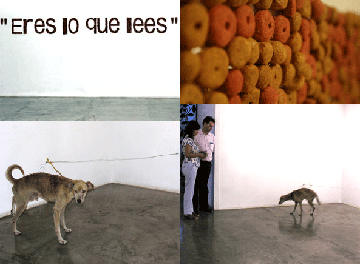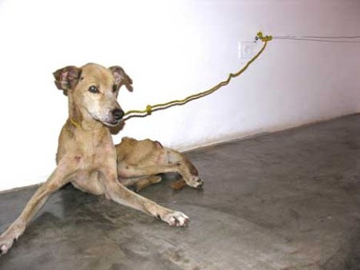What are the ethical implications of using live animals in art?
In 1974, Joseph Beuys caged himself with a live coyote for a performance piece called I Like America and America Likes Me. The artist spent a week living with the coyote, eventually learning how to co-exist with the animal. His intention was to highlight the strained relationship between the coyote and European settlers in America, and its representation of the damage done to the continent and native cultures.

Joseph Beuys, "I Like America and America Likes Me," 1974. Photo: Caroline Tisdall. Courtesy Ronald Feldman Fine Arts, New York.
In 1993, Damien Hirst presented In and Out of Love, filling a gallery with hundreds of live tropical butterflies hatching from white canvases, feeding on sugar syrup, mating, laying eggs and dying, to illustrate the brevity of life and the inevitability of death. Years later, the artist had a tiger shark killed to be used in his work, The Physical Impossibility of Death in the Mind of Someone Living.
In 2003, the graffiti artist Banksy painted live animals from head to hoof in an exhibit called Turf War, causing an animal activist to chain herself to railings surrounding a decorated cow, despite the animal’s conditions being approved by the RSPCA (The Royal Society for the Prevention of Cruelty to Animals).
In 2007, artistic freedom and expression was challenged in an exhibition by artist Huang Yong Ping, entitled Theatre of the World at the Vancouver Art Gallery. Lizards, scorpions, tarantulas, and insects were exhibited in conditions deemed improper for the animals by the SPCA, an organization whose mission is to advance the well-being of animals. The artist decided to remove the animals from the exhibit in protest, in order to maintain the integrity of the artwork.
As much as these works outraged animal rights activists, perhaps no other exhibition has caused as much controversy over the ethical use of live animals in art as Exposición No.1. A show of work by Guillermo Vargas, a Costa Rican artist also known as “Habacuc,” took place on August 16, 2007 at Galería Códice in Managua, Nicaragua. Written in dog food on a gallery wall was the statement, “Eres lo que lees,” meaning, “You are what you read.” The center of attention was a sickly-looking street dog tied to a metal cable bolted to the wall with a short rope. The animal was supposedly captured in the alleys of Managua by some children who were paid by the artist. According to hundreds of blogs and news articles circulating on the Internet, the artist intended for the dog to starve to death during the course of the exhibition. Vargas intended to raise awareness of the public’s hypocrisy by comparing what happened to this dog to a burglar named Natividad Canda Mayrena, who was mauled to death by two rottweilers in Costa Rica while the police and onlookers watched.
The outrage that ensued over the Internet and via mass media outlets culminated in a petition that was signed by over four million people worldwide, calling for the artist to be boycotted from the Central American Biennial Honduras 2008 and for criminal charges to be filed against him. Filled with outrage, I signed the petition as well. Later I read that Vargas also signed the petition, claiming that an artist always signs his work. This seemed curious to me, so I decided to investigate the facts behind the exhibition and was surprised by what I learned.
It helped that I could read in Spanish, as I soon discovered that not one blog or news source that covered the exhibition could confirm whether the dog actually died. The outlets were getting their information from the same source, a blog published by a friend of the artist, called “El Perrito Vive,”or “The Dog Lives.”
Throughout my research, it became clear that this work was part of an Internet art project. Exposición No 1 is one component of a larger work of art called Eres lo que lees, which employs misinformation and manipulates mass media via the Internet. One of the aims of this project was to demonstrate the hypocrisy in real world and art world ethics. Take a dog off the streets and put it into a gallery and it becomes an ethical phenomenon, while stray dogs and most real human suffering are ignored or given minimal attention.
Another purpose was to incite a reaction, making the spectator, like the dog, an unwilling participant in the work. This illustrates how easily we can be manipulated into believing what news outlets want us to. The title, “You Are What You Read,” illustrates this point very well. If one artist can manipulate over four million people around the world, imagine the ability that governments, corporations, and religious entities have to do the same.
According to the gallery owner, the dog was in the gallery for nine hours a week, and was well-fed with dog food supplied by Habacuc. One night after being fed by the night watchmen, the dog escaped by passing through the iron gate at the main entrance. In an interview, the artist clearly states that the dog died in the artwork, but he never said that the dog died in real life. Ambiguity was his intention.
The use of live animals in art has raised many ethical questions regarding what art is and what art should be. Should live animals be used as art objects at all? An art object may have aesthetic value regardless of whether it is ethical or not, but an artist should be held accountable if it can be proved that his or her actions deliberately caused inhumane suffering. Through the image of a starving dog, Guillermo Vargas’s artwork Eres lo que lees opens our minds to the hypocrisy of real world and art world ethics, and the lack of attention given to both human and animal suffering.
David Yanez an Ecuadorian-born artist who lives and works in New York City, NY.





Pingback: The Digest. 03.05.10. « C-MONSTER.net
Pingback: Practical Uses for Metal Cable Ties
Pingback: What’s Cookin at the Art21 Blog: A Weekly Index | Art21 Blog
Pingback: Oh, for real? « Vshusd's Blog
Pingback: Jason Alba (al – buh)» Blog Archive » Influence: Art, Religion, Government, You
Pingback: Ejects I, Graph I; Natividad « Paresthesiac